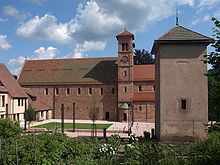Reichenbach Monastery (Baden-Württemberg)
The Reichenbach Monastery was a Benedictine monastery in Klosterreichenbach , a district of the municipality of Baiersbronn in the Murg Valley . The Romanesque founding church dates back to 1083.
history
The foundation goes back to a donation to the Hirsau monastery . The founder was a man named Bern, about whom nothing more is known. According to the Reichenbach donation book , in May 1082 three monks and five lay brothers from the Hirsau Monastery set out for the northern Black Forest where the Reichenbach flows into the Murg.
In 1085 the monastery church was taken over by Bishop Gebhard III of Constance . von Zähringen inaugurated in honor of Saint Gregory . The place name Gregorszell was not able to gain acceptance in the period that followed. The monastery church essentially consists of a single-nave Romanesque nave. In addition to the monastery church, other parts of the building were built such as: the convent building , the hospital , a novice's house , a mill , a cattle yard and a hostel . The last construction work was carried out in the 16th century.
In the monastery church, the foundation building built according to the Hirsau model (Sankt Aurelius) is still preserved. The Romanesque nave, single-nave and flat-roofed, the walls of the vestibule and the basement of the eastern towers date from the 11th century. Towards the end of the 12th century, the old choir was expanded into a three-aisled basilica building with a new apse, the retained east towers received passages, the ceilings 1230/40 cross vaults; at that time the vestibule was redesigned based on the Maulbronn model.
Reichenbach Monastery always remained a priory of Hirsau Monastery and remained dependent on it. The bailiwick rights of the monastery lay with the Counts of Eberstein . On the basis of the priory of the Hirsau monastery, the Counts of Württemberg registered claims to the Reichenbach monastery. The conflict between Baden and Eberstein on the one hand and Württemberg on the other intensified when the Hirsau monastery was reformed in 1535 and Duke Friedrich I of Württemberg occupied the monastery in 1595 . In 1603 the Reichenbach monastery was reformed and a Protestant pastor was appointed. Some parts of the monastery such as the mill and courtyards were sold. During the Thirty Years' War the monastery was re-Catholicized and repopulated by monks from the Benedictine Abbey of St. Martin in Wiblingen . The monks had to withdraw again after the Peace of Westphalia .
In the 19th century, the monastery was rediscovered as a monument and renovated according to the ideas of the time. Between 1965 and 1968, the church was restored to the original Romanesque style of a monk's church. The floor plan of the church is strongly reminiscent of the floor plan of St. Aurelius Church in Hirsau . The community used one of the towers as a sobering cell and a former fruit box first as a hospital and then as a granary. The evangelical Beate-Paulus- Kindergarten was built in this building in 1991 , named after a daughter of Philipp Matthäus Hahn , who worked as a pastor's wife in Klosterreichenbach from 1800 to 1810.
Today the Protestant parish is located in the monastery building .
Figural corner bulbs on the Romanesque pillar base of the south choir
Possessions
The origins of the possessions of the Reichenbach Monastery went back to foundations at the Hirsau Monastery. The possessions were primarily on both sides of the Murgtal , on the upper Neckar , on the upper Nagold and partially free float in the lower Rhine valley and lower Neckar.
literature
- Regina Keyler (arr.): The oldest land register of the Reichenbach Priory from 1427 . Kohlhammer, Stuttgart 1999, ISBN 3-17-015562-8
- Regina Keyler: Debit and credit. On the economic history of the Hirsau Priory Reichenbach . (= Writings on Southwest German Regional Studies, Volume 55). Thorbecke, Ostfildern 2005, ISBN 3-7995-5255-3
- Stephan Molitor: The Reichenbacher donation book (= publications of the commission for historical regional studies in Baden-Württemberg, series A, volume 40). Kohlhammer, Stuttgart 1997 ISBN 3-17-013148-6
Web links
- Benedictine priory of Klosterreichenbach in the database of monasteries in Baden-Württemberg of the Baden-Württemberg State Archives
Coordinates: 48 ° 31 ′ 32 " N , 8 ° 24 ′ 5" E







